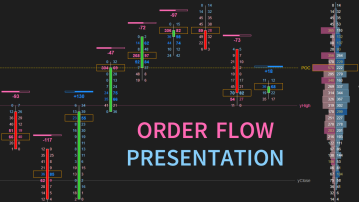Analyzing the movement of stocks provides insights into potential future directions. This method, known as technical analysis, relies on historical data and is a common practice in the field of investing. It often complements fundamental analysis in decision-making processes.
So, what exactly is a technical indicator?
Think of it as a mathematical tool designed to predict potential price changes. It considers various factors such as past prices, trading volume, or open interest (especially for derivatives). Traders leverage these indicators on charts to make informed guesses about future price movements. The interesting part is that as a trader, you have the flexibility to customize these indicators to align with your preferred approach.
However, it's not a straightforward process of applying these indicators. Testing them is crucial to determine their effectiveness. This step is vital because many indicators undergo regular updates, and traders are constantly introducing new ones. To assess the reliability of an indicator, traders engage in backtesting. This involves comparing the indicator's predictions with actual market outcomes. If there's consistency between the two, the indicator holds potential utility in making informed investment decisions.
Together, let's find out top 5 indicators for a beginner to start with:
1. Renko charts
Elite day traders have shifted from traditional bar charts, including candlesticks, to Renko charts, and they haven't looked back. Traditional charts, whether open-high-low-close bars or candlesticks, tend to be cluttered and challenging. Renko charts offer a clear and streamlined alternative. With their standard setting, Renko charts eliminate irregular candlestick bar sizes and distracting price wicks, providing precision and reduced noise for day traders. Choosing Renko charts has become a straightforward preference for those seeking clarity in their trading decisions.
You can claim your FREE ninZaRenko here for a smooth start with day trading: https://ninza.co/product/ninzarenko
2. Volume Weighted Average Price (VWAP)
Now, let's talk about indicators. The first one is VWAP, which stands for Volume Weighted Average Price. This indicator gives you the average price of a stock throughout the trading day, considering the volume associated with each price level. It's an intraday tool, not suitable for daily charts. For instance, buying below VWAP when you're a long-biased trader may not be ideal, as it indicates the stock is under the control of sellers. Understanding whether a stock is generally bullish or bearish is crucial, and VWAP helps in this assessment.
3. Moving Averages (MAs)
Moving on to MAs, or Moving Averages, specifically, Exponential Moving Averages (EMAs), which give more weight to recent price action. MAs represent the average price of a stock over a certain period, commonly 9, 20, and 200. The choice of these periods offers a balanced view across different timeframes, helping you gauge trends on various charts. Overlays, like the daily 200 moving average on a one-minute chart, can provide a comprehensive understanding of price movements, especially in identifying potential resistance levels.
4. Volume Bars
The third critical element in day trading involves examining volume bars. Together with candlestick patterns, volume bars offer crucial information for interpreting market dynamics. For instance, a candle indicating a potential reversal becomes more significant when accompanied by a surge in volume, signifying strong market participation.
5. Bollinger Bands
Now, let's discuss Bollinger Bands, a volatility indicator that utilizes Simple Moving Average (SMA) and volatility as key parameters. Observing the convergence of these lines indicates a reduction in volatility. Instances, where prices approach the lower Bollinger band, might signify an oversold condition, prompting traders to consider buying opportunities. Seasoned traders often emphasize the importance of analyzing trends while concurrently studying Bollinger Bands' patterns.
In conclusion, keeping it simple in chart analysis is recommended. Overloading charts with numerous indicators may lead to confusion. Trading success requires adaptability to evolving market conditions. Therefore, a judicious combination of candlestick patterns, VWAP, EMAs, volume analysis, and Bollinger Bands forms a robust foundation for informed decision-making in day trading.
In the trading game, simplicity is your secret weapon. Picture this: some traders clutter their charts with a ton of indicators – not a wise move. Trading is like navigating through a maze; you want to minimize losses, not dodge them altogether. The magic happens when you find that perfect indicator that vibes with your unique trading style. It's like finding your trading soulmate – and that's where success unfolds.
Welcome to ninZa.co
At ninZa.co, a leading indicator provider on NinjaTrader 8, we take pride in offering an extensive selection of indicators tailored to meet your specific needs and complement your unique trading style. Our indicators are designed to guide you through your journey into day trading, ensuring a smooth and promising start to your trading endeavors.
Begin exploring our shop directly below:






![[Package] Deliberate AnaCute Trading](https://nizaco-media.nyc3.digitaloceanspaces.com/catalog/product/cache/8ff38408075023c595809570dc58e4db/_/p/_package_deliberate_anacute.jpg)






![[Vendor] Daily Fib Trader (3 months)](https://nizaco-media.nyc3.digitaloceanspaces.com/catalog/product/cache/8ff38408075023c595809570dc58e4db/m/a/maxresdefault_45_1.jpg)

![[System] ThunderZilla](https://nizaco-media.nyc3.digitaloceanspaces.com/catalog/product/cache/8ff38408075023c595809570dc58e4db/t/h/thunderzlilla.png)



![[System] Cosmik Z-TP](https://nizaco-media.nyc3.digitaloceanspaces.com/catalog/product/cache/8ff38408075023c595809570dc58e4db/c/o/cosmik_z-tp_1.png)

![[Sister Brand] King Kong Trading RK](https://nizaco-media.nyc3.digitaloceanspaces.com/catalog/product/cache/8ff38408075023c595809570dc58e4db/k/i/king_kong_trading_rk_nz_.png)

![[Package] King Kong Trading](https://nizaco-media.nyc3.digitaloceanspaces.com/catalog/product/cache/8ff38408075023c595809570dc58e4db/k/i/king_kong_trading_1.png)
![[Sister Brand] Fleet Barracuda Scalping](https://nizaco-media.nyc3.digitaloceanspaces.com/catalog/product/cache/8ff38408075023c595809570dc58e4db/_/p/_package_fleet_barracuda_scalping.jpg)
![[Sister Brand] Sabertooth Tiger Trading](https://nizaco-media.nyc3.digitaloceanspaces.com/catalog/product/cache/8ff38408075023c595809570dc58e4db/_/p/_package_sabertooth_tiger_trading.jpg)
![[Sister Brand] Fibar Scalping](https://nizaco-media.nyc3.digitaloceanspaces.com/catalog/product/cache/8ff38408075023c595809570dc58e4db/f/i/fibar_scalping.jpg)
![[Package] Snow Eagle Trading](https://nizaco-media.nyc3.digitaloceanspaces.com/catalog/product/cache/8ff38408075023c595809570dc58e4db/_/p/_package_snow_eagle_trading.jpg)


![[Package] Double Dragons Trading](https://nizaco-media.nyc3.digitaloceanspaces.com/catalog/product/cache/8ff38408075023c595809570dc58e4db/_/p/_package_double_dragons_trading.jpg)

![[Package] Agile Piranha Scalping](https://nizaco-media.nyc3.digitaloceanspaces.com/catalog/product/cache/8ff38408075023c595809570dc58e4db/_/p/_package_agile_piranha_scalping.jpg)


![[Package] Lightning Leopard Trading](https://nizaco-media.nyc3.digitaloceanspaces.com/catalog/product/cache/8ff38408075023c595809570dc58e4db/_/p/_package_lightning_leopard_trading.jpg)


![[Sister Brand] Noble Cloud](https://nizaco-media.nyc3.digitaloceanspaces.com/catalog/product/cache/8ff38408075023c595809570dc58e4db/n/o/noble_cloud.png)



![[Vendor] Easy Trader](https://nizaco-media.nyc3.digitaloceanspaces.com/catalog/product/cache/8ff38408075023c595809570dc58e4db/m/d/mdveasytrader.png)

![[Free] Zigzag Swing 4U](https://nizaco-media.nyc3.digitaloceanspaces.com/catalog/product/cache/8ff38408075023c595809570dc58e4db/z/i/zigzag_swing_4u.jpg)



![[Sister Brand] SuperTrend RK](https://nizaco-media.nyc3.digitaloceanspaces.com/catalog/product/cache/8ff38408075023c595809570dc58e4db/s/u/supertrend_rk.png)
![[Sister Brand] Solar Wind RK](https://nizaco-media.nyc3.digitaloceanspaces.com/catalog/product/cache/8ff38408075023c595809570dc58e4db/s/o/solar_wind_rk.jpg)

![[Free] DEMA Colorized 4U](https://nizaco-media.nyc3.digitaloceanspaces.com/catalog/product/cache/8ff38408075023c595809570dc58e4db/d/e/dema_colorized_4u.png)
![[Free] ZLEMA Colorized 4U](https://nizaco-media.nyc3.digitaloceanspaces.com/catalog/product/cache/8ff38408075023c595809570dc58e4db/z/l/zlema_colorized_4u_1.png)
![[Free] WMA Colorized 4U](https://nizaco-media.nyc3.digitaloceanspaces.com/catalog/product/cache/8ff38408075023c595809570dc58e4db/w/m/wma_colorized_4u_1_1.png)
![[Free] VWMA Colorized 4U](https://nizaco-media.nyc3.digitaloceanspaces.com/catalog/product/cache/8ff38408075023c595809570dc58e4db/v/w/vwma_colorized_4u_1_1.png)
![[Free] TMA Colorized 4U](https://nizaco-media.nyc3.digitaloceanspaces.com/catalog/product/cache/8ff38408075023c595809570dc58e4db/t/m/tma_colorized_4u.png)
![[Free] TEMA Colorized 4U](https://nizaco-media.nyc3.digitaloceanspaces.com/catalog/product/cache/8ff38408075023c595809570dc58e4db/t/e/tema_colorized_4u.png)
![[Free] LinReg Colorized 4U](https://nizaco-media.nyc3.digitaloceanspaces.com/catalog/product/cache/8ff38408075023c595809570dc58e4db/l/i/linreg_colorized_4u.png)
![[Free] HMA Colorized 4U](https://nizaco-media.nyc3.digitaloceanspaces.com/catalog/product/cache/8ff38408075023c595809570dc58e4db/h/m/hma_colorized_4u.png)
![[Free] EMA Colorized 4U](https://nizaco-media.nyc3.digitaloceanspaces.com/catalog/product/cache/8ff38408075023c595809570dc58e4db/e/m/ema_colorized_4u.png)
![[Free] SuperTrend 4U](https://nizaco-media.nyc3.digitaloceanspaces.com/catalog/product/cache/8ff38408075023c595809570dc58e4db/s/u/supertrend_4u.png)
![[Free] SMA Colorized 4U](https://nizaco-media.nyc3.digitaloceanspaces.com/catalog/product/cache/8ff38408075023c595809570dc58e4db/s/m/sma_colorized_4u_1.png)


![[Free] Trend Magic 4U](https://nizaco-media.nyc3.digitaloceanspaces.com/catalog/product/cache/8ff38408075023c595809570dc58e4db/t/r/trend_magic_4u.png)










![[Vendor] Profit Sniper Coaching](https://nizaco-media.nyc3.digitaloceanspaces.com/catalog/product/cache/8ff38408075023c595809570dc58e4db/P/r/ProfitSniper_Logo-1.png)





![[Vendor] QTN Click Trader](https://nizaco-media.nyc3.digitaloceanspaces.com/catalog/product/cache/8ff38408075023c595809570dc58e4db/Q/T/QTN_ClickTrader.png)
![[Vendor] QTN Custom Chart Trader Buttons](https://nizaco-media.nyc3.digitaloceanspaces.com/catalog/product/cache/8ff38408075023c595809570dc58e4db/Q/T/QTN_CustomChartTraderButtons.png)

![[Vendor] MDV Range Summaries](https://nizaco-media.nyc3.digitaloceanspaces.com/catalog/product/cache/8ff38408075023c595809570dc58e4db/M/D/MDVRangeSummaries.png)
![[Sister Brand] HelloWin Analytics](https://nizaco-media.nyc3.digitaloceanspaces.com/catalog/product/cache/8ff38408075023c595809570dc58e4db/h/e/hellowin_analytics.png)


![[Free] Chart Watermark](https://nizaco-media.nyc3.digitaloceanspaces.com/catalog/product/cache/8ff38408075023c595809570dc58e4db/c/h/chart_watermark.png)




![[Vendor] BloodHound & BlackBird Bundle](https://nizaco-media.nyc3.digitaloceanspaces.com/catalog/product/cache/8ff38408075023c595809570dc58e4db/v/e/vendor-bloodhound-blackbird-bundle-feature.png)
![[Vendor] BlackBird](https://nizaco-media.nyc3.digitaloceanspaces.com/catalog/product/cache/8ff38408075023c595809570dc58e4db/v/e/vendor-blackbird-feature.png)
![[Vendor] BloodHound](https://nizaco-media.nyc3.digitaloceanspaces.com/catalog/product/cache/8ff38408075023c595809570dc58e4db/v/e/vendor-bloodhound-featured.png)
![[Vendor] T-Stop Algo Profit](https://nizaco-media.nyc3.digitaloceanspaces.com/catalog/product/cache/8ff38408075023c595809570dc58e4db/v/e/vendor-ZiP-feature.png)
![[Vendor] iCOT](https://nizaco-media.nyc3.digitaloceanspaces.com/catalog/product/cache/8ff38408075023c595809570dc58e4db/v/e/vendor-iCOT-featured.png)


![[Free] ninZaATR](https://nizaco-media.nyc3.digitaloceanspaces.com/catalog/product/cache/8ff38408075023c595809570dc58e4db/n/i/ninzaatr.png)
![[Free] Trading Time](https://nizaco-media.nyc3.digitaloceanspaces.com/catalog/product/cache/8ff38408075023c595809570dc58e4db/t/r/trading_time.png)
![[Vendor] Programming Service](https://nizaco-media.nyc3.digitaloceanspaces.com/catalog/product/cache/8ff38408075023c595809570dc58e4db/E/m/Emet-ProgrammingService.jpg)

![[Vendor] Talking Alert for Labeled Lines](https://nizaco-media.nyc3.digitaloceanspaces.com/catalog/product/cache/8ff38408075023c595809570dc58e4db/I/n/Indicators4Traders-TalkingAlert.png)
![[Vendor] Telegram ShareService](https://nizaco-media.nyc3.digitaloceanspaces.com/catalog/product/cache/8ff38408075023c595809570dc58e4db/I/n/Indicators4Traders-TelegramShareService.png)








![[Free] Price Following](https://nizaco-media.nyc3.digitaloceanspaces.com/catalog/product/cache/8ff38408075023c595809570dc58e4db/p/r/price_following.png)











































![[Free] ninZaRenko](https://nizaco-media.nyc3.digitaloceanspaces.com/catalog/product/cache/8ff38408075023c595809570dc58e4db/n/i/ninzarenkonnnn.jpg)

![[Free] Bar Duration](https://nizaco-media.nyc3.digitaloceanspaces.com/catalog/product/cache/8ff38408075023c595809570dc58e4db/b/a/bar_duration.png)

![[Free] Williams VIX Fix](https://nizaco-media.nyc3.digitaloceanspaces.com/catalog/product/cache/8ff38408075023c595809570dc58e4db/w/i/williams_vix_fix_1.png)



![[Free] Bar Status](https://nizaco-media.nyc3.digitaloceanspaces.com/catalog/product/cache/8ff38408075023c595809570dc58e4db/b/a/bar_status_1.png)







![[Free] USD Index](https://nizaco-media.nyc3.digitaloceanspaces.com/catalog/product/cache/8ff38408075023c595809570dc58e4db/u/s/usd_index_1.png)

![[Free] Moving Median 4U](https://nizaco-media.nyc3.digitaloceanspaces.com/catalog/product/cache/8ff38408075023c595809570dc58e4db/m/o/moving_median_4u.png)
![[Free] Karthik Dynamic RSI](https://nizaco-media.nyc3.digitaloceanspaces.com/catalog/product/cache/8ff38408075023c595809570dc58e4db/k/a/karthik_dynamic_rsi.png)
![[Free] Bollinger %B](https://nizaco-media.nyc3.digitaloceanspaces.com/catalog/product/cache/8ff38408075023c595809570dc58e4db/b/o/bollinger_b.png)

![[Free] Bid-Ask Display](https://nizaco-media.nyc3.digitaloceanspaces.com/catalog/product/cache/8ff38408075023c595809570dc58e4db/b/i/bid-ask_display.png)


![[Free] Horizontal Label](https://nizaco-media.nyc3.digitaloceanspaces.com/catalog/product/cache/8ff38408075023c595809570dc58e4db/h/o/horizontal_label.png)

![[Free] Quick Drawing](https://nizaco-media.nyc3.digitaloceanspaces.com/catalog/product/cache/8ff38408075023c595809570dc58e4db/q/u/quick_drawing_1.png)

